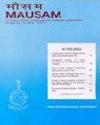Assessing the impact of temperature and rainfall on mustard yield through detrended production index
IF 0.7
4区 地球科学
Q4 METEOROLOGY & ATMOSPHERIC SCIENCES
引用次数: 0
Abstract
The present study was conducted aiming to evaluate the individual and combined impact of temperature and rainfall on mustard yield through detrended production index for five districts of West Bengal viz., Hooghly, Nadia, Burdwan, Mursidabad and South 24 Parganas. The crop data and weather information were collected from various stations of those five locations. The selected study areas belong to different agroclimatic zones of the state, namely old alluvial zone, new alluvial zone and coastal saline zone. Mustard growing season in these districts starts from middle of October and continues upto middle of January (Rabi season). The detailed information on yield for 18 years (1997 to 2014) was collected from Government of West Bengal and weather data were collected from India Meteorological Department. The entire growing season of mustard was divided into vegetative and reproductive stages for convenience of the study. Although a definite trend among them existed. Moreover, when all the five locations are considered, overall increase in the year-wise yield was significant with R2 value 0.63. Some R square had poor values. Higher values of R2 indicated the significance of technological trend in case of Hooghly (R2 = 0.46), Nadia (R2 = 0.65) and South 24 Parganas (R2 = 0.73) districts where as it was not significant for Burdwan and Mursidabad. A gradual decrease in yield was observed with temperature increment from 0.50C to 2.00C. The results indicated a reduction of 0.36%, 0.72%, 1.01% and 1.4% in mustard yield in 0.50C, 10 C, 1.50C and 20C increased temperature condition, respectively. Declined yield of mustard will be 908 kg ha-1 in the study location at 20C more temperature condition. Yield reduction is more if higher temperature coincides with the vegetative stage. Time of sowing should be adjusted so that vegetative stage can escape the high temperature period. But all other required management practices should be performed along with the mentioned one. Otherwise several other biotic and abiotic stresses may lower down the yield too. Thus, the results of this work strongly support the idea of engaging DPI to evaluate the impacts of prime weather parameters on crop production and generate yield forecasting models based on that利用产量趋势指数评价温度和降雨对芥菜产量的影响
本研究旨在通过趋势生产指数评估温度和降雨对西孟加拉邦五个地区(Hooghly、Nadia、Burdwan、Mursidabad和South 24 Parganas)芥菜产量的单独和综合影响。作物数据和天气信息是从这五个地点的不同站点收集的。所选研究区属于国家不同的农业气候带,即旧冲积带、新冲积带和沿海盐碱带。这些地区的芥菜生长季节从10月中旬开始,一直持续到1月中旬(拉比季节)。18年(1997年至2014年)的详细产量信息收集自西孟加拉邦政府,天气数据收集自印度气象部门。为便于研究,将芥菜整个生长季节分为营养期和繁殖期。尽管他们之间存在着明确的趋势。此外,当考虑所有五个地点时,总体产量逐年增长显著,R2值为0.63。有些R平方值很差。在Hooghly (R2 = 0.46)、Nadia (R2 = 0.65)和South 24 Parganas (R2 = 0.73)地区,R2值较高表明技术趋势显著,而在Burdwan和Mursidabad地区则不显著。温度从0.50℃升高到2.00℃,产量逐渐降低。结果表明,在升温0.50℃、10℃、1.5℃和20℃条件下,芥菜产量分别降低0.36%、0.72%、1.01%和1.4%。在20℃以上温度条件下,试验点芥菜减产908 kg ha-1。如果较高的温度与营养阶段相吻合,产量下降更大。播种时间应调整,使营养阶段能避开高温期。但是,所有其他必需的管理实践都应该与上述管理实践一起执行。否则,其他几种生物和非生物胁迫也可能降低产量。因此,这项工作的结果有力地支持了利用DPI来评估主要天气参数对作物生产的影响,并在此基础上生成产量预测模型的想法
本文章由计算机程序翻译,如有差异,请以英文原文为准。
求助全文
约1分钟内获得全文
求助全文
来源期刊

MAUSAM
地学-气象与大气科学
CiteScore
1.20
自引率
0.00%
发文量
1298
审稿时长
6-12 weeks
期刊介绍:
MAUSAM (Formerly Indian Journal of Meteorology, Hydrology & Geophysics), established in January 1950, is the quarterly research
journal brought out by the India Meteorological Department (IMD). MAUSAM is a medium for publication of original scientific
research work. MAUSAM is a premier scientific research journal published in this part of the world in the fields of Meteorology,
Hydrology & Geophysics. The four issues appear in January, April, July & October.
 求助内容:
求助内容: 应助结果提醒方式:
应助结果提醒方式:


